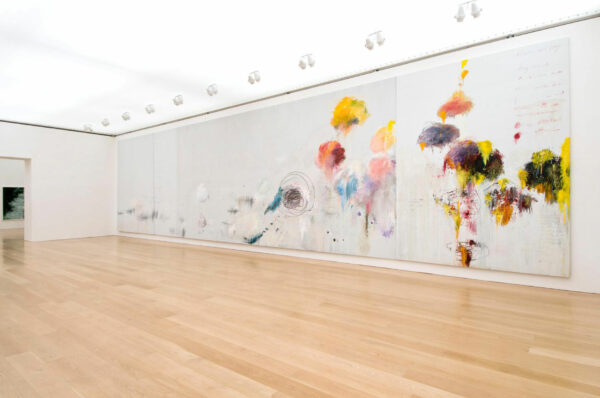The Menil Collection’s Cy Twombly Galleries came alive with an immediacy of intention and the unmistakable power of organic connection as music made by pianist and composer Myra Melford’s Fire And Water Quintet seized the moment and took the room’s captive audience on their creative journey. A stellar band of powerfully expressive musicians, the quintet, co-presented by the Menil Collection and Nameless Sound, performed two sold-out sets of music tributing the work of Cy Twombly. In particular, they took inspiration from his Gaeta Set (For The Love Of Fire And Water), a series of canvases Melford first saw in the collection of the Museum Brandhorst in Munich.
Set up in front of Twombly’s magnificent 30-foot-long canvas Untitled (Say Goodbye, Catullus, to the Shores of Asia Minor), the quintet performed music from their CDs For The Love Of Fire And Water and Hear The Light Singing (put out on RogueArt in 2022 and 2023, respectively), inspired by the above mentioned Gaeta Set series. The sets also included “insertions” as Melford describes them, which reacted to the monumental oeuvre by Twombly that shared the band’s performance space. A compelling and agile composer and improviser, Melford has written about her long standing affinity for Twombly’s work and her desire to explore his creative process as she explores and defines her own.
As the first set begins with Melford soloing, the notes pop up from her piano, curve, and land, one after another, cascading, gaining momentum until they fall like rain. The delicate white forms of Twombly’s Untitled become a field of snow behind the band, a soft palette invaded by the pelting water. Gradually her solo gives way to her invitation for other members of the Fire & Water Quintet to enter. The energy builds until it explodes into a funk groove, Tomeka Reid’s electric cello digging into the bass line as if her instrument has suddenly been transformed into an electric bass guitar. She hooks up with percussionist Lesley Mok and the band is off, bouncing, the energy accelerating. This is no tepid groove; this is music with a big bite.
Throughout the compositions, the form of the music alternates between written material and inspired improvisational interaction, sometimes between the entire band, but often splintering off into creative duets that showcase each musician’s sound and creativity. Improvised moments are magical because they live in a world that encompasses everything that has come before them, and yet what they truly bring forth is only ever of the moment of their creation. Improvisation creates its own special universe where the integrity of intention opens the plane of our existence, and artists and audience alike share in the immediacy and interconnectedness of life.
All the musicians in the Fire And Water Quintet are each a powerhouse of sound and ideas. Everything cellist Tomeka Reid plays feels rich and unexpected, from her virtuosic melodies to her shimmering extended technique. I am a huge fan of the renowned bassist Jimmy Garrison. Reid conjures, for me, Garrison’s ability to construct a story in the most abstract sense. In Reid’s improvised solos and duets, she reaches out and surrounds us so we become enthralled with the musical narrative she composes. Mary Halvorson on electric guitar brings forth an expansive palette of sound and energy, constantly shifting and responding to the currents of the music.
In one stunning moment, saxophonist Ingrid Laubrock begins to play a duet with Melford, matching her melodic line with a delicate vibrato that plays in and out of pitch of the pianist’s notes. It is a profoundly intimate interplay between them that pulls us into the space, closer and closer to them. In other compositional sections — one of which for me seemed to nod to the harmonies of Billy Strayhorn’s BloodCount — Laubrock’s tenor floated soulfully over the music with a tone and color reminiscent of the great saxophonist Charles Lloyd. This is not to say that Laubrock’s sound is not completely unique, but rather to convey her incredible prowess on the instrument, from the bending of notes in beautiful dissonance to the sound and color of the great saxophone lineage of modern jazz.
Lesley Mok is newer to the quintet; the first Fire And Water recording features Susie Ibara on drums. Mok brings a smoldering rumble of power to the energized sections of the set. Every band member shines on their respective instruments, but their performance becomes about the interaction, listening, and honest communication between them and us.
Melford has written that she has been interested in Twombly’s work since she first saw it at the Museum of Modern Art in 1994. John Waters, the filmmaker and friend of Twombly, sees the artist’s scribbly writing as an act of rebellion. In the same way, the quintet’s creative power lies in a spirit of liberation, an openness to the interpretation of the moment. In an interview with Sotheby’s, Waters explained: “I think if you look at any Cy Twombly painting, if you really start to see it, you can imagine what those scribbles and what those words mean, and make them speak to you and translate to yourself. I think that’s a part of the enjoyment of Cy Twombly’s work.”
Remembering the imagery of rain in the snow and the freshness and comfort of winter that came to me as I listened to the music, I decided to do a little reading about Twombly’s Untitled. I was quite surprised to find some gallerists and writers who espoused quite a somber interpretation of this masterpiece. I have always found the painting exceedingly cheerful, and I feel good when I am in the room with it. I revisited the gallery the next day and walked the length of the painting from right to left. I begin with what I perceive as vibrant trees in autumn, bursting with the color of flames, past the round form, that is to me like a rock, around which some blue nautical creature emerges to surround with an embrace. And then I enter the expanse of snowy sea that stretches across the left third of the painting. I arrive at the words written by Twombly on the far left side of the canvas, words that would have lurked quite close to Melford’s piano the night before: “shining white air trembling.” Indeed it was.





